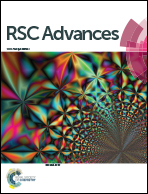Solvatochromism of bright carbon dots with tunable long-wavelength emission from green to red and their application as solid-state materials for warm WLEDs†
Abstract
Herein, we present a facile approach to produce long-wavelength emitting carbon dots (CDs). A shift of the fluorescence emission wavelength of CDs from 630 nm to 520 nm can be easily acquired. The as-synthesized CDs exhibit concentration-dependent PL property as well as the “solvatochromism” phenomenon, which are rarely known in CDs. As the concentration or solvent polarity of the CDs increases, the photoluminescence (PL) wavelength exhibits a red shift. More importantly, the QY of these long-wavelength CDs is as high as 52.4%, which is considerably higher than that mentioned in other reports. Moreover, on addition of an acid (HCl), the surface H+-functionalization on the CDs leads to strong quenching of fluorescence emission, which is almost reversible after the addition of a strong base (NaOH). Then, CDs based solid-state composites were fabricated using a combination of polyvinyl butyral (PVB) and CDs. Finally, CDs/PVB composites were deposited on the Ce3+:Y3Al5O12 (Ce3+:YAG) phosphor-in-glass (Ce-PiG) via a screen-printing technology. Warm white light-emitting diodes (WLEDs) were then fabricated using these materials and GaN chips. The results indicate that these CDs possess a potential for future applications in warm WLEDs.



 Please wait while we load your content...
Please wait while we load your content...